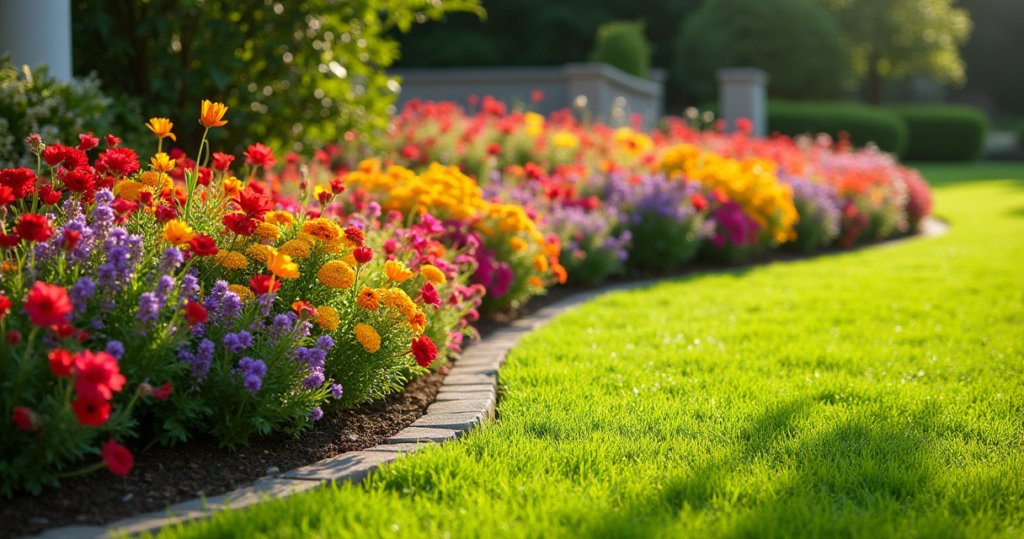Your lawn is more than just grass—it’s a canvas waiting for your creative touch. Whether you have a sprawling yard or a modest patch of green, thoughtful design elements can transform this everyday space into a vibrant outdoor sanctuary that reflects your personality and enhances your quality of life.
As someone who’s spent years integrating cultural elements into garden spaces, I’ve seen how even small changes can dramatically shift how a garden feels and functions. The following lawn garden ideas range from simple weekend projects to more ambitious transformations, but each offers a pathway to creating a more beautiful, functional, and personally meaningful outdoor space.
1. Define Borders with Vibrant Flower Beds
Flower beds along your lawn’s perimeter create visual separation while introducing color, texture, and personality to your landscape. These vibrant borders draw the eye, transforming plain lawn edges into dynamic focal points that can change with the seasons. Well-designed borders also serve practical purposes, deterring foot traffic from cutting corners and creating buffer zones between different garden areas.
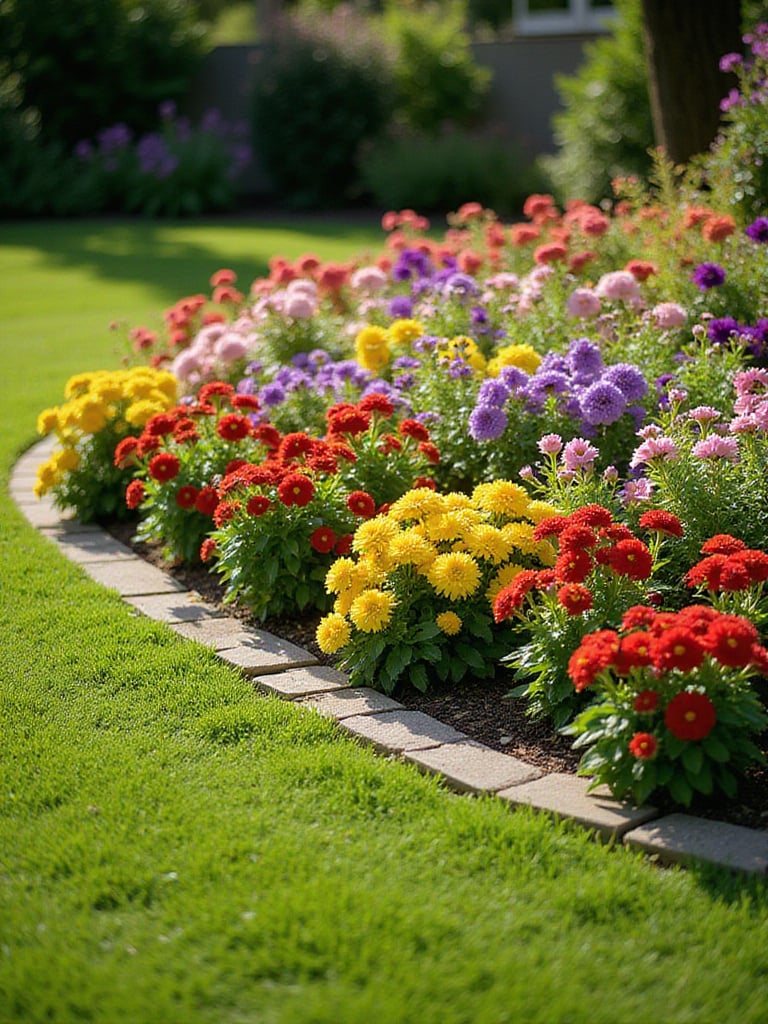
When selecting plants for borders, consider creating a “river of color” by planting masses of a single vibrant variety that winds along the edge. This technique, popular since Victorian gardens, creates dramatic visual impact with minimal planning. Focus on plants with staggered bloom times to ensure continuous color, and remember to prepare your soil properly before planting by amending with compost for improved drainage and fertility.
The inspiration for this collection struck when I visited a small village in Oaxaca, where homes featured borders bursting with native zinnias and marigolds—proving that even the simplest flower border can transform an ordinary lawn into something extraordinary.
2. Install a Charming Garden Path or Stepping Stones
Adding pathways through your lawn garden serves both practical and aesthetic purposes. Functionally, they prevent soil compaction and plant damage by directing foot traffic. Visually, they add structure and invite exploration, leading visitors to discover focal points or creating a sense of journey through your outdoor space.
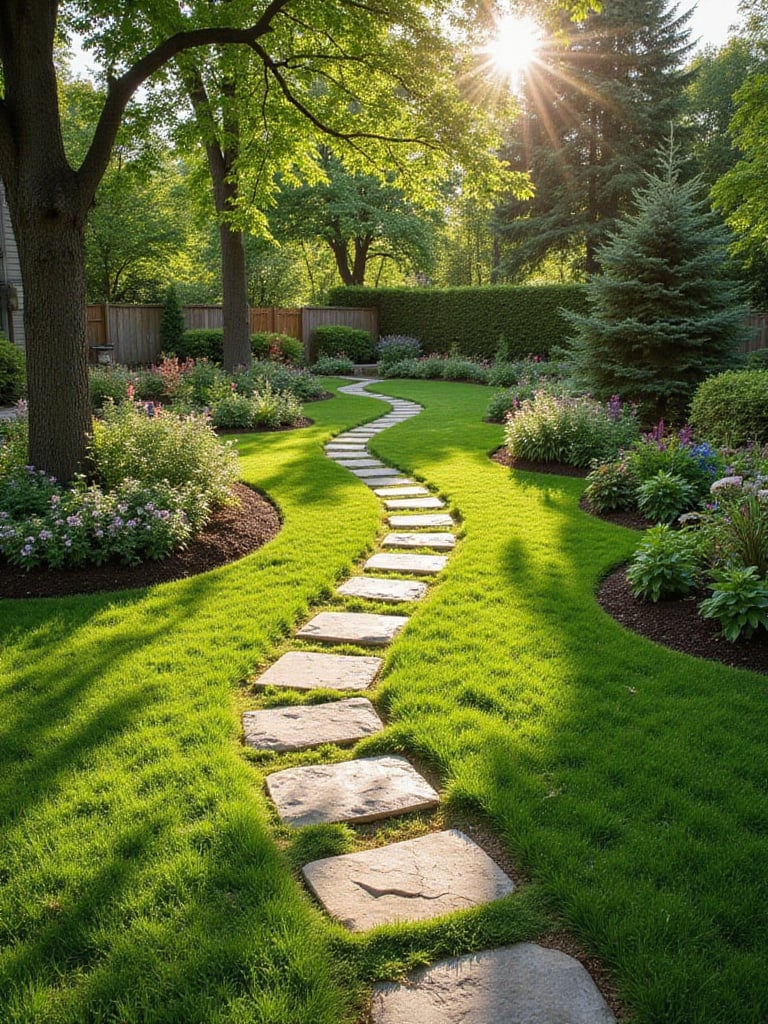
For a natural, organic look, use large, irregularly shaped stepping stones placed slightly apart, allowing low-growing ground covers like creeping thyme or moss to fill the gaps. This technique, inspired by traditional Japanese gardens, encourages visitors to slow down and appreciate the surrounding details. When installing, dig shallow depressions so each stone sits level with or slightly above the lawn for easy mowing and to prevent tripping.
The craftsmanship in this collection tells a story of how paths can transform not just how we move through a space, but how we experience it—connecting different garden elements while adding their own character and charm to your lawn garden ideas.
3. Create a Low-Maintenance Rock Garden Feature
Rock gardens offer striking visual interest while requiring minimal upkeep, making them perfect for busy homeowners or challenging areas of your lawn. These structural elements help suppress weeds, reduce the need for watering, and create microenvironments for specialized plants that might otherwise struggle in your landscape.
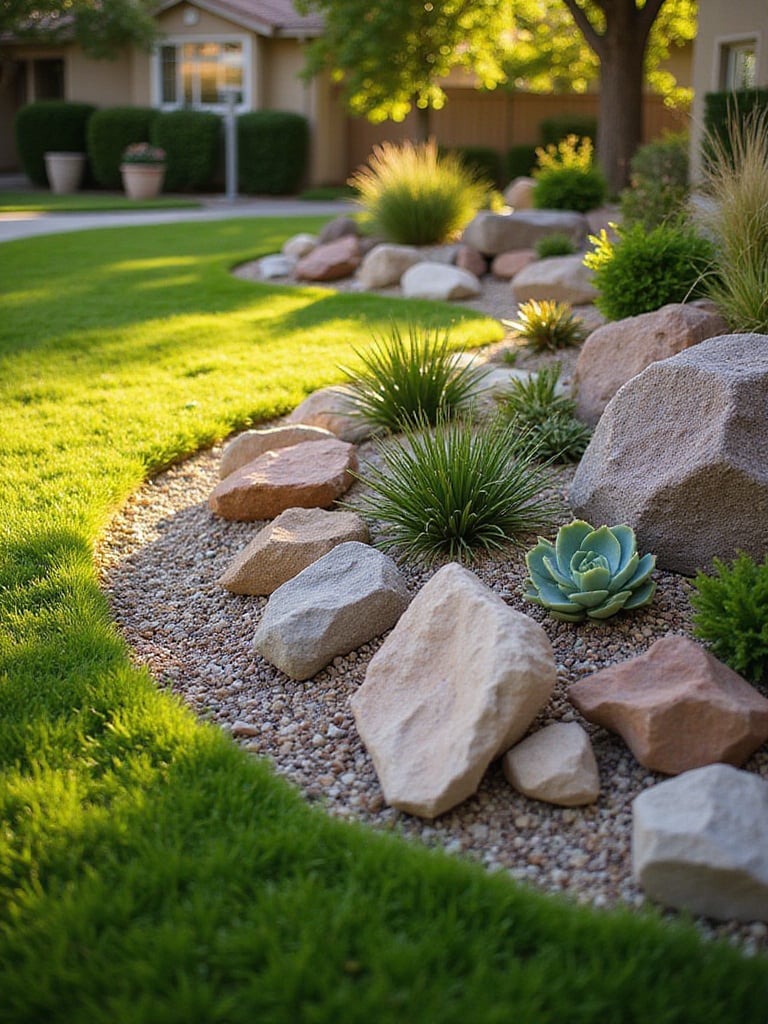
Consider creating a raised rock garden bed within your lawn area, using larger stones as retaining elements to build height and improve drainage. This approach makes the feature a prominent focal point while providing excellent growing conditions for alpine plants, succulents, and other rock garden favorites. Choose plants adapted to well-drained conditions, such as:
- Sedum varieties (stonecrop)
- Sempervivum (hens and chicks)
- Dwarf conifers
- Small ornamental grasses like Blue Fescue
- Alpine plants like Saxifraga and Lewisia
The environmental story behind this piece began with ancient garden traditions—many Japanese Zen gardens are a form of rock garden, using carefully placed stones and raked gravel to represent landscapes and philosophical concepts, emphasizing tranquility rather than abundant growth.
4. Go Vertical with a Stunning Living Wall
Living walls transform ordinary vertical surfaces into extraordinary garden features, making them ideal lawn garden ideas for small spaces or areas where you want to create dramatic visual impact. These vertical gardens utilize specialized systems that allow plants to root into panels attached to walls, bringing life to previously unused dimensions in your outdoor space.
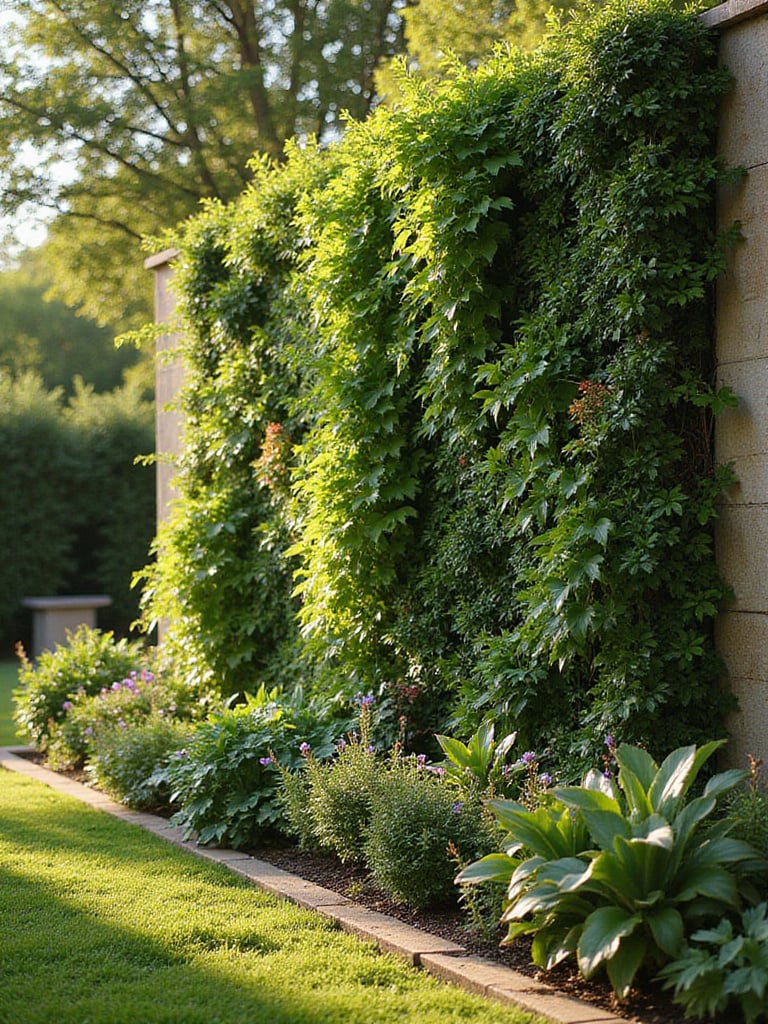
When designing a living wall, consider both aesthetics and practicality. Choose plants with similar water and light requirements, focusing on those with fibrous root systems that will establish well in vertical conditions. Good options include ferns, succulents, small perennials, and certain herbs like thyme or mint. The location is crucial—assess sunlight exposure, wind patterns, and proximity to water sources before installation, ensuring your wall has the right conditions for your chosen plants.
The unexpected environmental benefit comes from how living walls improve air quality, provide insulation, reduce noise pollution, and create habitats for pollinators—all while saving valuable ground space in your lawn garden design.
5. Build Practical and Beautiful Raised Garden Beds
Raised beds offer excellent drainage, prevent soil compaction, and make gardening more accessible by reducing bending and kneeling. They also create clear definition between different areas of your lawn garden, adding architectural interest even in winter when plants have died back.
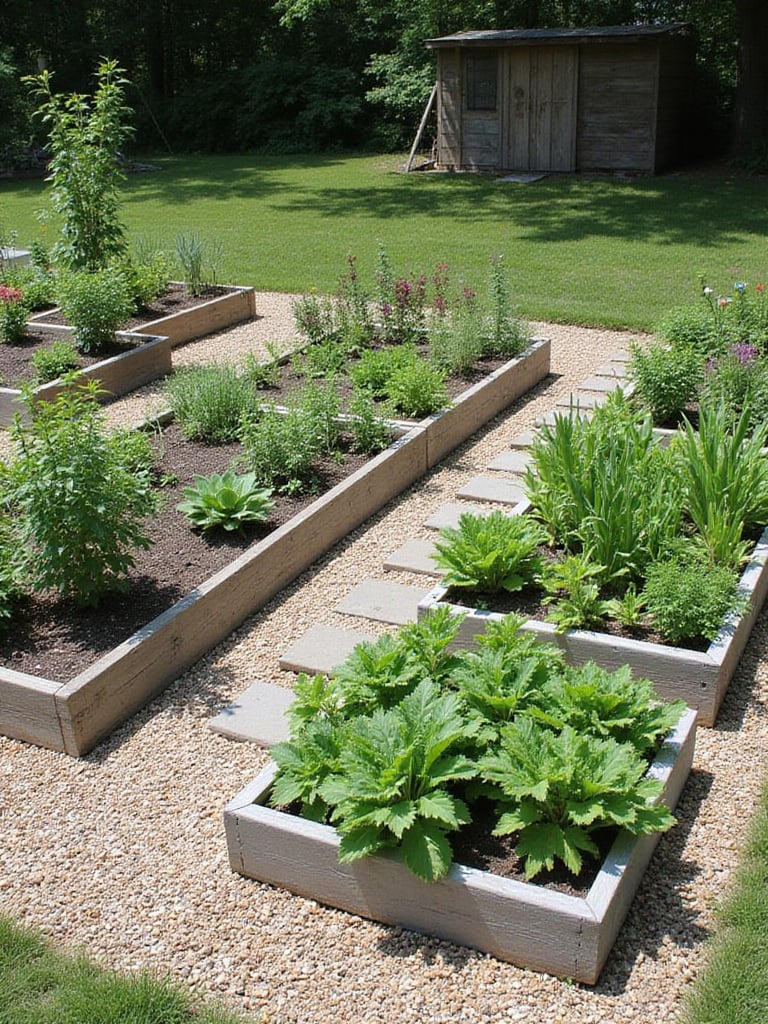
For maximum visual impact, consider creating tiered or multi-level raised beds that add vertical interest while accommodating plants with different soil depth requirements. This approach, reminiscent of medieval monastery gardens, combines practicality with aesthetics. When building raised beds, choose materials that complement your home’s architecture:
“The raised beds in my garden aren’t just growing spaces—they’re architectural elements that organize my landscape and make harvesting a joy rather than a chore.” — Garden designer Julie Moir Messervy
The traditional methods used result in garden spaces that are not only more productive but also more beautiful, creating a harmonious blend of form and function that elevates your entire lawn garden design.
6. Add Tranquility with a Small Pond or Fountain
Water features bring multiple dimensions to lawn garden ideas—the gentle sound masks unwanted noise, the reflective surface adds sparkle and movement, and the presence of water attracts beneficial wildlife like birds, butterflies, and dragonflies. Even a small water element can become a captivating focal point in your outdoor space.
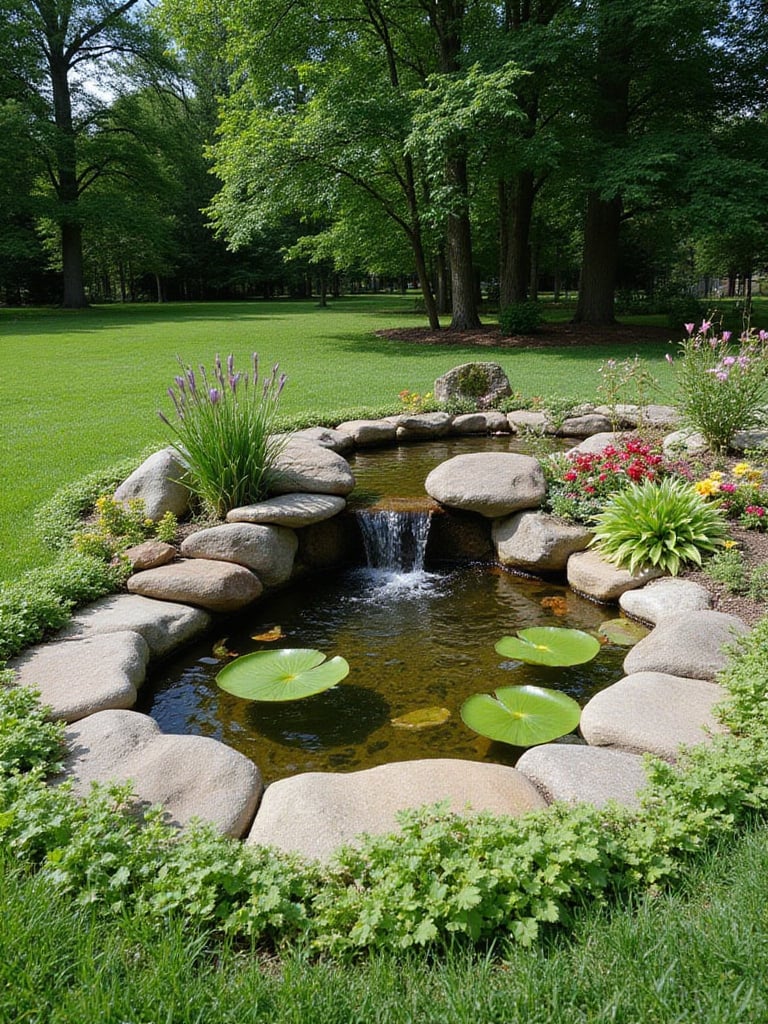
For a low-maintenance option, consider a “disappearing” or pondless fountain where water bubbles up from a decorative feature like a stone or sculpture before vanishing into an underground reservoir filled with gravel. This design eliminates concerns about standing water while still providing the visual and auditory benefits. Before installation, carefully mark out the desired shape and size, considering how it fits with existing garden elements and ensuring proper access to electrical sources for the pump.
The magic of this piece lies in its ability to transform the atmosphere of your entire garden—studies have shown that the sound of trickling water lowers stress levels and improves mood, making it one of the most impactful lawn garden ideas you can implement.
7. Design a Cozy Outdoor Seating Area or Patio Nook
Creating a dedicated seating area transforms your lawn garden from a space you merely look at into one you truly inhabit. These intimate retreats provide comfortable spots for relaxation, reading, dining, or simply enjoying the sights and sounds of your garden throughout the changing seasons.
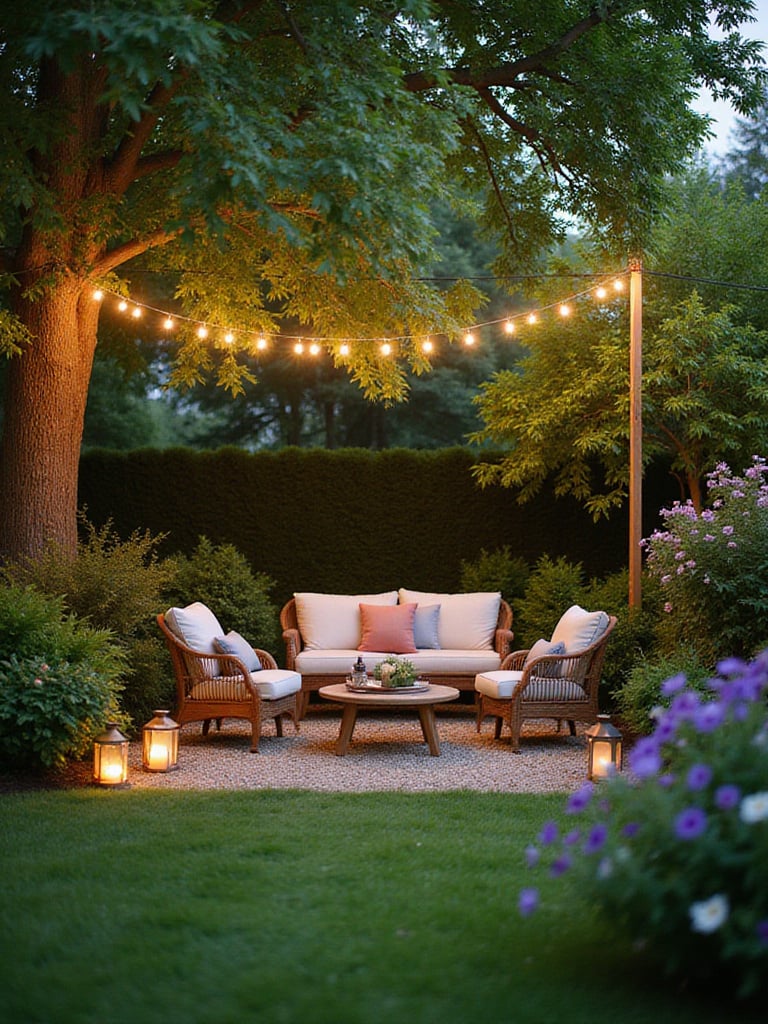
For a particularly enchanting space, create a “secret garden” nook tucked behind a hedge or trellis covered in climbing roses, accessible via a small winding path. Furnish it with a comfortable armchair or small bistro set, then add layers of comfort with outdoor cushions, throws, and perhaps an outdoor rug. Complete the atmosphere with appropriate lighting for evening use—string lights, lanterns, or solar path lights extend the usability of your space well after sunset.
Picture the warmth of evening conversations around this special retreat, where the boundaries between indoor and outdoor living blur, and your lawn garden becomes an extension of your home’s most comfortable spaces.
8. Illuminate Your Garden with Strategic Outdoor Lighting
Thoughtful lighting transforms your lawn garden after dark, highlighting architectural features, ensuring safe navigation of pathways, and creating magical nighttime ambiance. Well-designed lighting extends the usability of your outdoor space and showcases your garden’s best features even after the sun goes down.

Try uplighting the canopy of a mature tree to create dramatic shadow patterns on the ground and highlight its structural beauty. This technique adds depth and dimension to nighttime garden scenes while providing ambient illumination for the surrounding area. Before purchasing fixtures, walk through your garden at night with a flashlight to identify key features you want to highlight, then sketch a lighting plan that includes:
- Path lights for safety and guidance
- Spotlights for accent features
- Well lights for subtle ground-level illumination
- Step lights if you have changes in elevation
- Ambient lighting for seating areas
The silhouette draws inspiration from natural moonlight filtering through trees, creating a subtle, nuanced lighting scheme that enhances rather than overwhelms your lawn garden ideas.
9. Plant Native Species to Attract Local Wildlife
Native plants form the foundation of healthy local ecosystems, providing essential food and habitat for the insects, birds, and other wildlife that have evolved alongside them over thousands of years. Incorporating these species into your lawn garden ideas not only supports biodiversity but also typically requires less water, fertilizer, and maintenance than non-native alternatives.
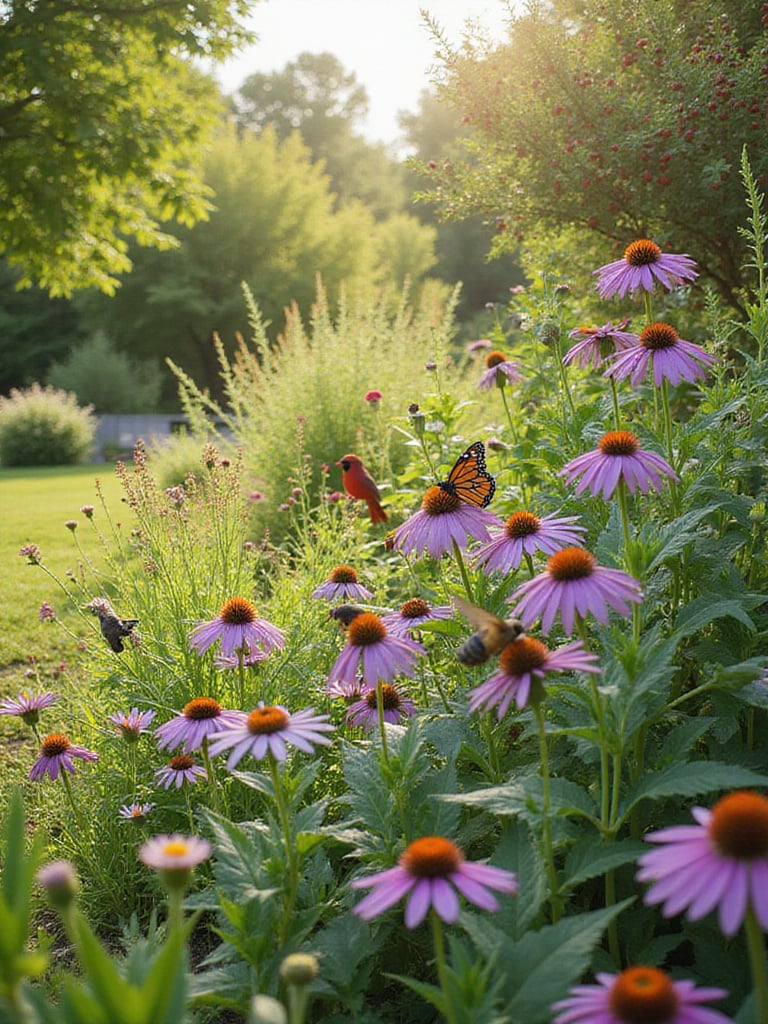
Create a dedicated “Pollinator Patch” within your lawn area, perhaps in a sunny corner or along a fence line. Remove the grass and plant densely with a mix of native wildflowers and pollinator-friendly shrubs that bloom at different times throughout the season. This approach ensures continuous food sources for bees, butterflies, and hummingbirds while creating a vibrant, ever-changing display. Research native plants specific to your local ecoregion through resources like:
- Your local cooperative extension office
- Native plant societies
- The National Wildlife Federation’s native plant finder
- Local botanical gardens
The unexpected material discovery story begins when you observe the first native bees, butterflies, and birds visiting your garden—bringing movement, sound, and life to your lawn garden in ways that no hardscaping or non-native plantings ever could.
10. Start a Productive Vegetable Patch
Transforming a portion of your lawn into a vegetable garden connects you with the age-old satisfaction of growing your own food while adding productive beauty to your landscape. Even a small patch can yield impressive harvests when properly planned and maintained.
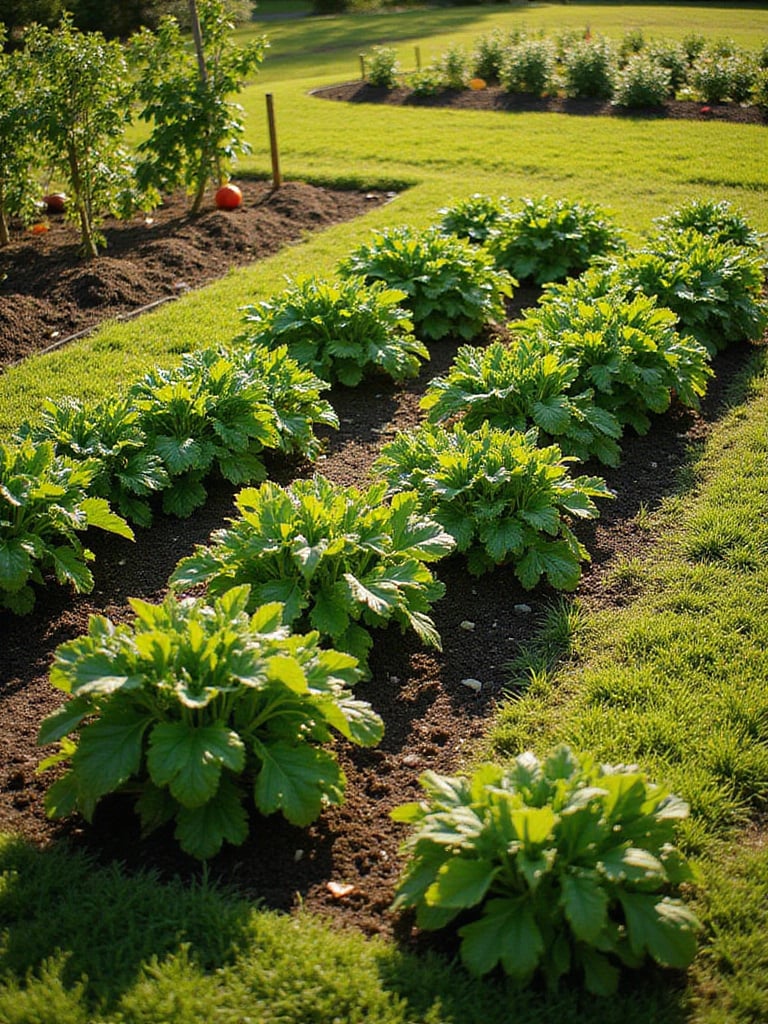
Design a formal “potager” style garden that mixes vegetables, herbs, and flowers in a decorative layout, making the patch a beautiful focal point rather than just a functional area. This French-inspired approach treats edible plants as ornamental elements, arranging them in geometric patterns with clearly defined beds and paths. Prepare your soil thoroughly by incorporating plenty of organic matter like compost or well-rotted manure to improve structure, drainage, and fertility—the foundation of any successful vegetable garden.
The artisan collective that creates these pieces understands that edible gardens can be as beautiful as they are productive, blending form and function in ways that enhance your overall lawn garden ideas while putting fresh, homegrown produce on your table.
11. Cultivate a Buzz with a Pollinator Garden for Bees and Butterflies
Creating a dedicated pollinator garden is not just beautiful—it’s essential ecological work. With global pollinator populations declining due to habitat loss and pesticide use, your lawn garden can become a crucial refuge for these vital creatures that support our food systems and native plant communities.
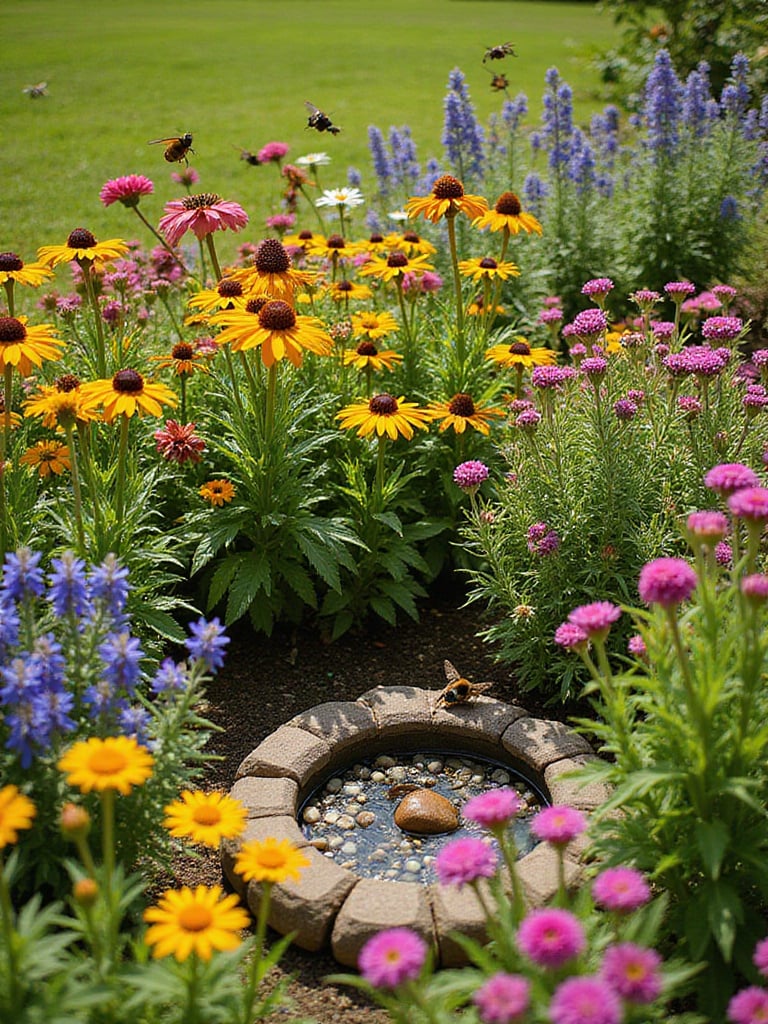
Beyond just planting flowers, an effective pollinator garden includes several key elements:
- Water source: A shallow dish with pebbles and water provides safe drinking for pollinators
- Host plants: Specific plants like milkweed for Monarch butterfly caterpillars
- Shelter: Areas of leaf litter, bare soil patches, or hollow stems for nesting
- Plant diversity: Different flower shapes, sizes, and bloom times to support various species
When clients ask us about balancing style with comfort, we recommend choosing a sunny spot in your lawn and removing the grass to create a dense planting of native wildflowers. This approach creates a visually stunning display while providing maximum ecological benefit—a perfect blend of beauty and purpose for your lawn garden ideas.
12. Incorporate Unique Garden Art and Sculptures
Garden art infuses your outdoor space with personality and creates focal points that draw the eye through the landscape. From traditional statues to contemporary abstract pieces, thoughtfully chosen art can express your aesthetic sensibilities while adding year-round interest to your lawn garden ideas.
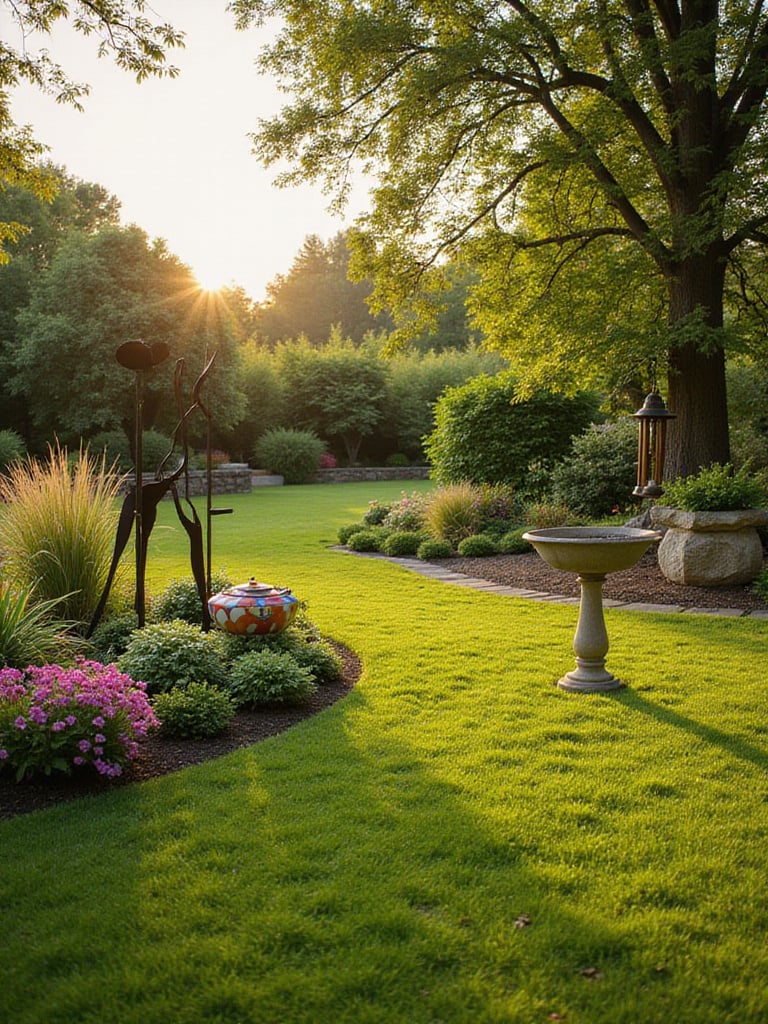
Install a series of kinetic sculptures or wind chimes near a patio or deck to add sound and movement to your garden experience. These dynamic elements respond to even the slightest breeze, creating an ever-changing sensory experience that engages visitors on multiple levels. Start with one or two key pieces in prominent locations rather than scattering many small items randomly—this creates more impact and prevents the space from feeling cluttered or chaotic.
The interplay between the colors creates fascinating relationships between your art and the surrounding plants, sometimes contrasting boldly and other times blending harmoniously as the garden changes through seasons—adding another layer of complexity to your lawn garden design.
13. Add Functionality with a Small Shed or Potting Bench
A well-designed shed or potting bench brings practical organization to your garden activities while serving as an attractive feature in its own right. These functional elements keep tools and supplies accessible and protected while providing dedicated workspace for garden tasks.
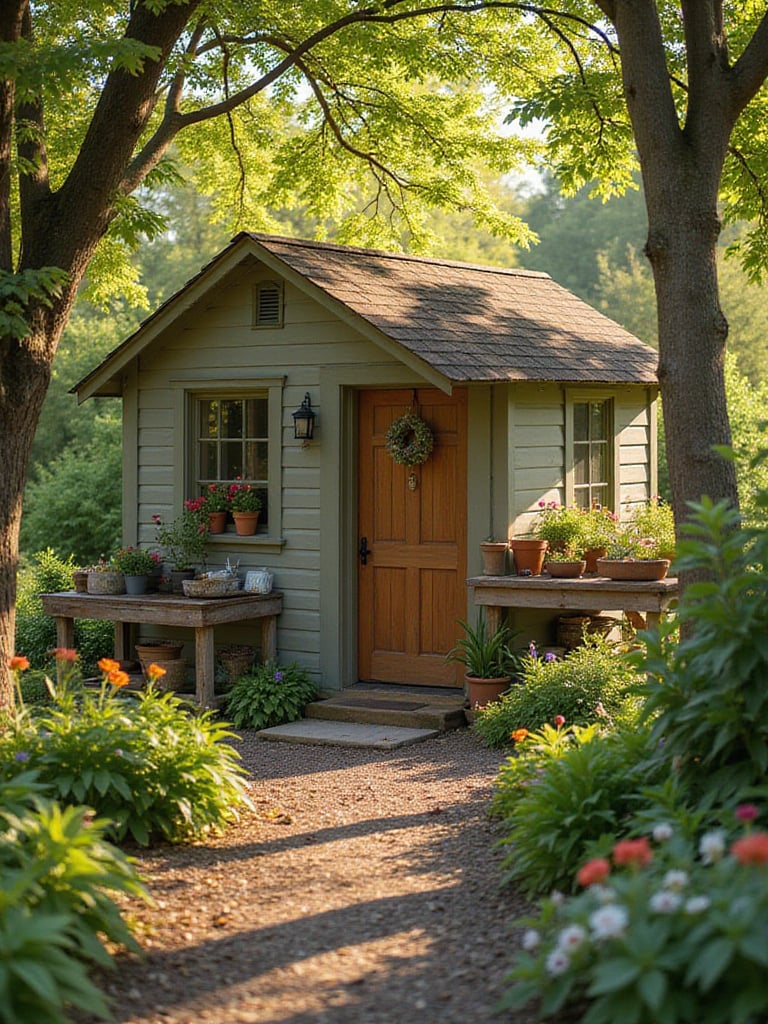
Design your shed or potting bench to complement your garden’s style using matching paint colors, roofing materials, or decorative elements like window boxes or trellises. This integration ensures it enhances rather than detracts from your overall lawn garden ideas. Historical estates often featured elaborate “potting sheds” that were both functional and beautiful, sometimes doubling as warm retreats for gardeners. Ensure your structure has a level, stable foundation—whether concrete slab, gravel base, or sturdy wooden frame—to prevent shifting or structural issues over time.
The maker’s journey from apprentice to master influenced how these garden structures evolved from purely utilitarian buildings to charming architectural elements that contribute significantly to the character and functionality of your lawn garden.
14. Use Decorative Mulch or Ground Cover for Texture
Mulch and ground covers do more than suppress weeds and retain moisture—they add distinctive textural elements that enhance your lawn garden ideas through contrast and visual interest. The right ground treatment can tie together disparate elements or create intentional separation between different garden areas.

Create defined garden beds using contrasting mulch textures—perhaps a bed with fine shredded mulch around delicate flowers adjacent to a path edged with larger, smooth river stones. This approach creates visual rhythm and guides the eye through your garden design. When using different mulches for texture, install physical dividers like plastic edging, metal strips, or pavers between areas to prevent materials from mixing over time and maintain crisp definition.
The visual weight balances perfectly when you thoughtfully combine different textures, creating a garden that feels cohesive yet interesting—where each material serves both practical and aesthetic purposes in your lawn garden design.
15. Design a Themed Garden (e.g., Zen, Cottage, Mediterranean)
A themed garden creates a cohesive, immersive experience by drawing on established design traditions with distinctive plant palettes, materials, and arrangements. Whether you transform your entire lawn or create a themed section, this approach brings focus and character to your outdoor space.
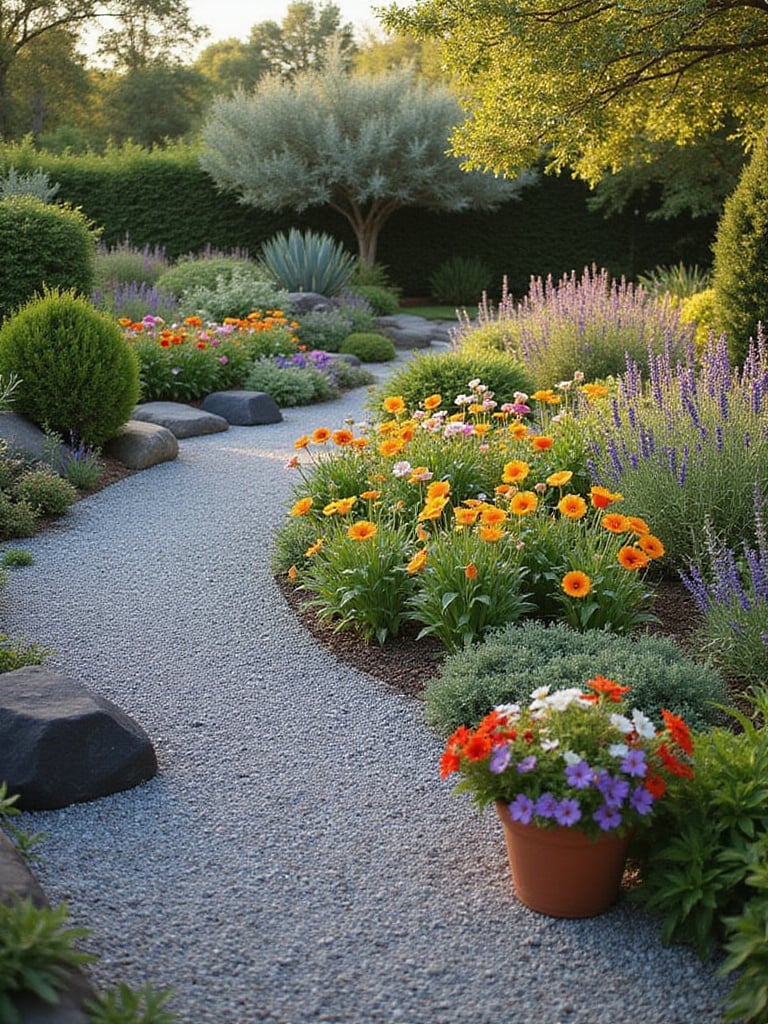
Consider creating a “Zen Corner” within your larger lawn garden using raked gravel, a few well-placed rocks, and a single sculptural plant or small water feature. This Japanese-inspired approach creates a meditative spot of tranquility without requiring a complete garden overhaul. Before starting, create a mood board or Pinterest collection with images that capture the essence of your chosen theme to guide your design decisions and plant selections.
For those hesitant about bold patterns, themed gardens offer a structured approach to design with proven aesthetic combinations—making it easier to achieve a polished, professional look in your lawn garden ideas even if you’re a novice gardener.
16. Add Structure with Strategically Planted Trees or Shrubs
Trees and shrubs provide the essential “bones” of your garden design, creating year-round structure, defining spaces, and anchoring the more ephemeral elements like perennials and annuals. These woody plants give your lawn garden architecture and substance even during dormant seasons.
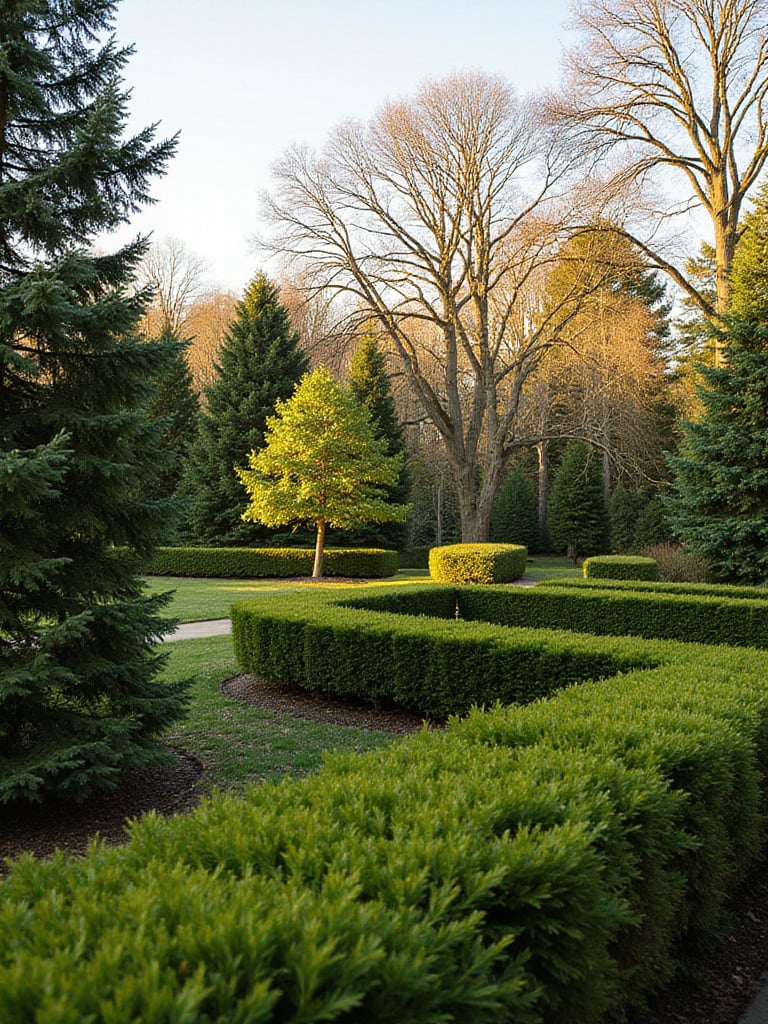
Use a single, striking specimen tree (like a Japanese Maple or Weeping Cherry) as a central focal point in a lawn area or garden bed. This creates an instant sense of maturity and draws the eye naturally to its distinctive form. When planting, consider:
- Mature size to ensure proper spacing
- Growth rate that matches your timeline
- Multi-seasonal interest (flowers, fall color, bark, etc.)
- Appropriate match for your soil and climate conditions
The craftsmanship reveals itself in details like the careful selection of woody plants that complement rather than compete with each other, creating a balanced composition that evolves beautifully as your lawn garden matures over the years.
17. Install an Arbor or Pergola for Vertical Interest
Arbors and pergolas add architectural presence to your lawn garden ideas, drawing the eye upward and creating defined transitions between different garden areas. These structures serve as both practical elements for supporting climbing plants and aesthetic features that add character and dimension.
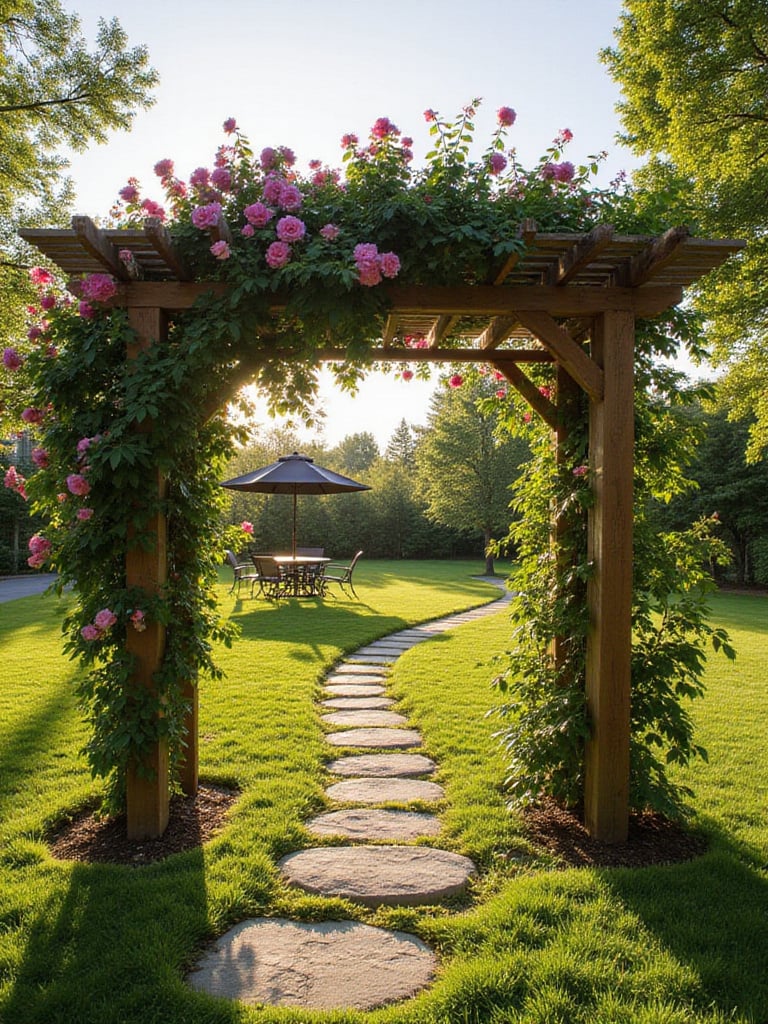
Install a pergola over a hammock or swing area within your lawn to create a secluded, shaded retreat perfect for relaxation. Surround it with climbing plants for extra privacy and beauty—options like clematis, climbing roses, wisteria, or grape vines add lush greenery, color, and sometimes fragrance at eye level and above. Ensure the structure is properly anchored into the ground using concrete footings or deep stakes to withstand wind and support the weight of mature climbing plants.
The evolution of this trend reflects broader cultural shifts toward outdoor living spaces that blur the boundaries between architecture and garden, creating rooms without walls that extend your living area into the landscape of your lawn garden.
18. Create a Discreet and Efficient Compost Area
A well-designed compost area transforms garden and kitchen waste into valuable soil amendment while maintaining the aesthetic integrity of your lawn garden. The key is making it both functional enough to produce quality compost and discreet enough not to detract from your garden’s beauty.
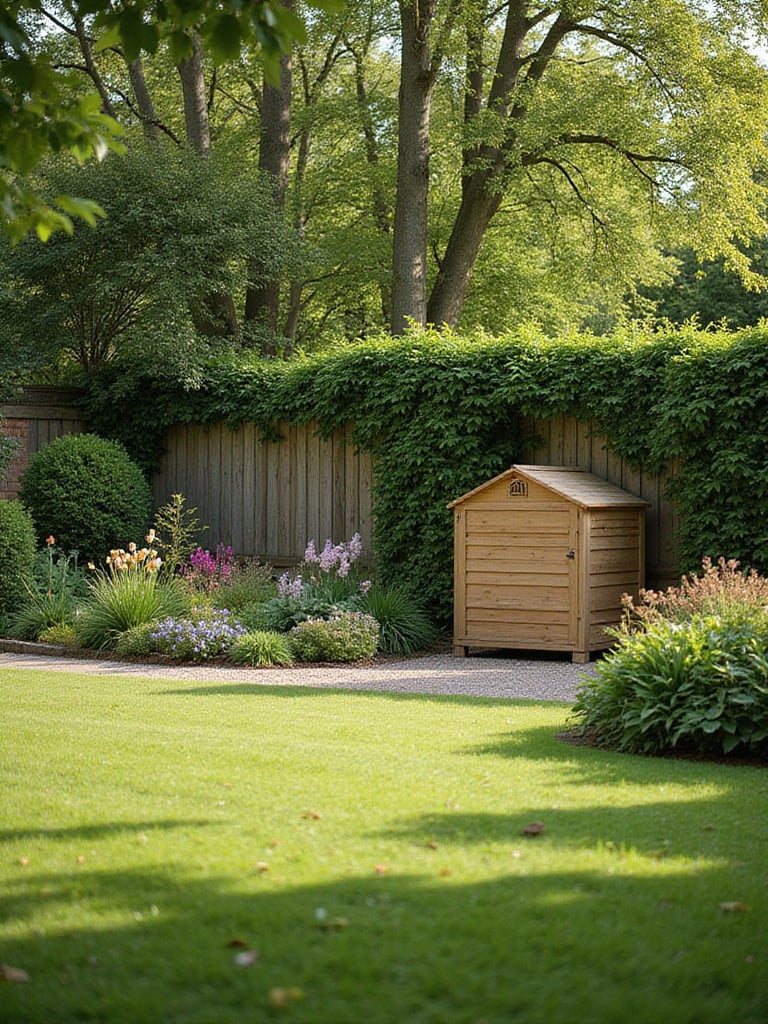
Screen your compost area using a decorative low fence, a living screen of evergreen shrubs, or a trellis supporting attractive climbing plants like clematis or jasmine. This approach hides the utilitarian aspect while potentially creating another attractive garden feature. Choose a location that balances convenience (easy access for adding materials) with discretion (not directly next to primary seating areas), preferably on bare soil to allow beneficial organisms easy access to the decomposing materials.
The sustainable journey of this material involves transforming what would be waste into garden gold—a perfect example of how practical lawn garden ideas can support both beauty and environmental responsibility in your outdoor space.
19. Brighten Up Spaces with Container Gardens
Container gardens offer unmatched flexibility, allowing you to add color and texture precisely where needed—even in areas without plantable soil like patios, decks, or entryways. These portable gardens create concentrated visual impact and can be easily changed with the seasons.

Use containers to define outdoor living spaces, placing them at corners or along edges and filling them with plants that spill over the sides for a lush, bright border effect. This technique creates garden rooms without permanent structures and can be adjusted as your needs change. When planting containers:
- Always use pots with drainage holes to prevent root rot
- Consider the “thriller, filler, spiller” approach for dynamic compositions
- Group plants with similar water and light needs
- Choose containers that complement your home’s architecture
Unlike conventional options, this approach reduces maintenance while maximizing impact—making container gardening one of the most versatile and rewarding lawn garden ideas for both beginners and experienced gardeners.
20. Build a Decorative Dry Creek Bed with a Small Bridge
A dry creek bed adds distinctive character to your lawn garden while potentially solving drainage issues. This landscape feature mimics a natural waterway using stones and gravel, creating visual interest even without actual flowing water.
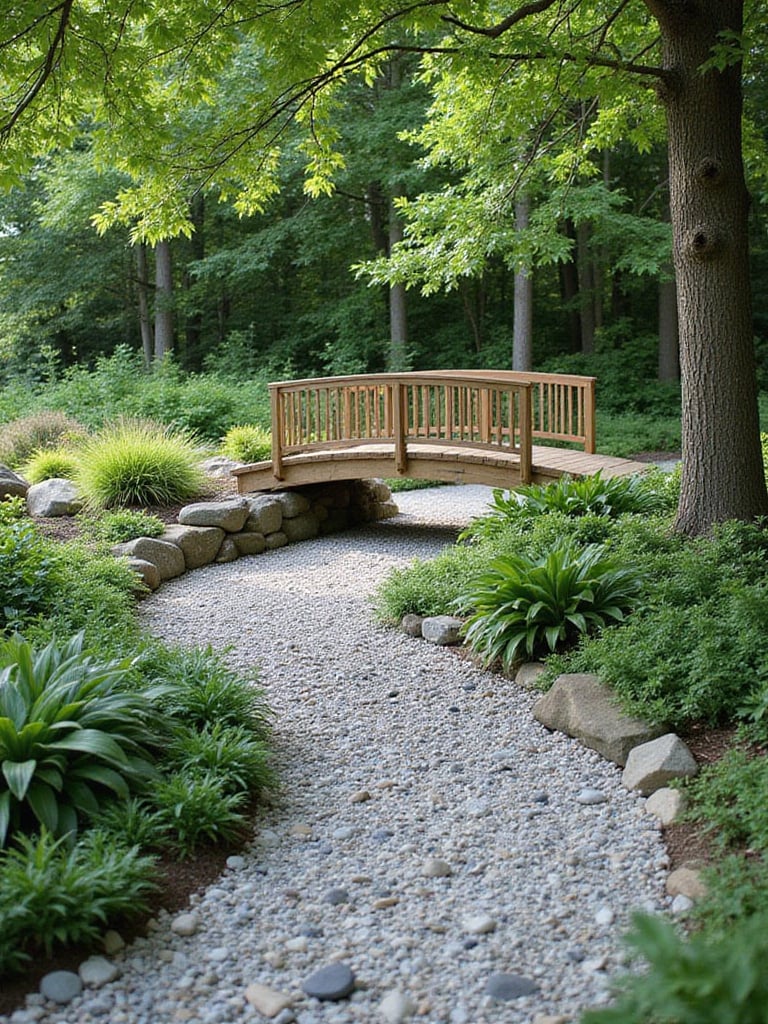
Incorporate native plants and groundcovers along the edges to soften the rock borders and create a natural, riparian-like habitat that attracts local wildlife. This naturalistic approach makes the feature appear as though it’s always been part of the landscape rather than a recent addition. Before digging, use a garden hose or rope to lay out the winding path, viewing it from different angles to ensure it flows naturally with the surrounding lawn garden ideas.
The design language evolved from traditional patterns that have deep roots in Japanese garden design, where similar features symbolize water, islands, and mountains—representing abstract landscapes that invite contemplation and appreciation of natural forms.
21. Welcome Birds with Feeders or a Bird Bath
Attracting birds brings movement, color, and song to your lawn garden while supporting beneficial creatures that help control pests naturally. Birds add life and animation to your outdoor space, creating moments of delight as they visit, bathe, and feed.
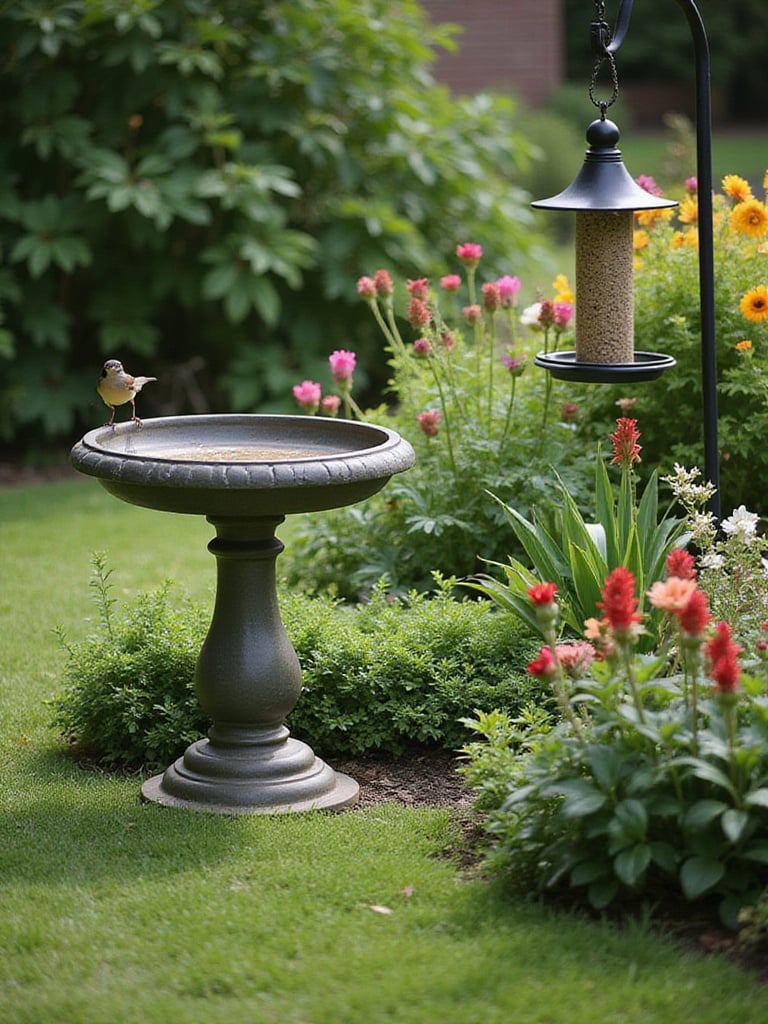
Integrate a decorative bird bath as a focal point within a flower bed or near a patio area where you can easily observe the visitors. Birds use baths not just for drinking but also for maintaining their feathers—essential for insulation and flight. Place feeders and baths in locations that offer birds quick access to nearby cover for safety while remaining visible from your home windows or seating areas for maximum enjoyment.
The material sourcing makes all the difference in how these garden elements perform and endure—choose weather-resistant materials for feeders and baths that will maintain their beauty through the seasons while providing safe, functional support for your feathered garden partners.
22. Simplify with a Low-Maintenance Landscape Design
A thoughtfully designed low-maintenance landscape saves time, money, and resources while still creating a beautiful outdoor environment. By focusing on sustainable practices and appropriate plant selections, you can create a lawn garden that looks great without demanding constant attention.
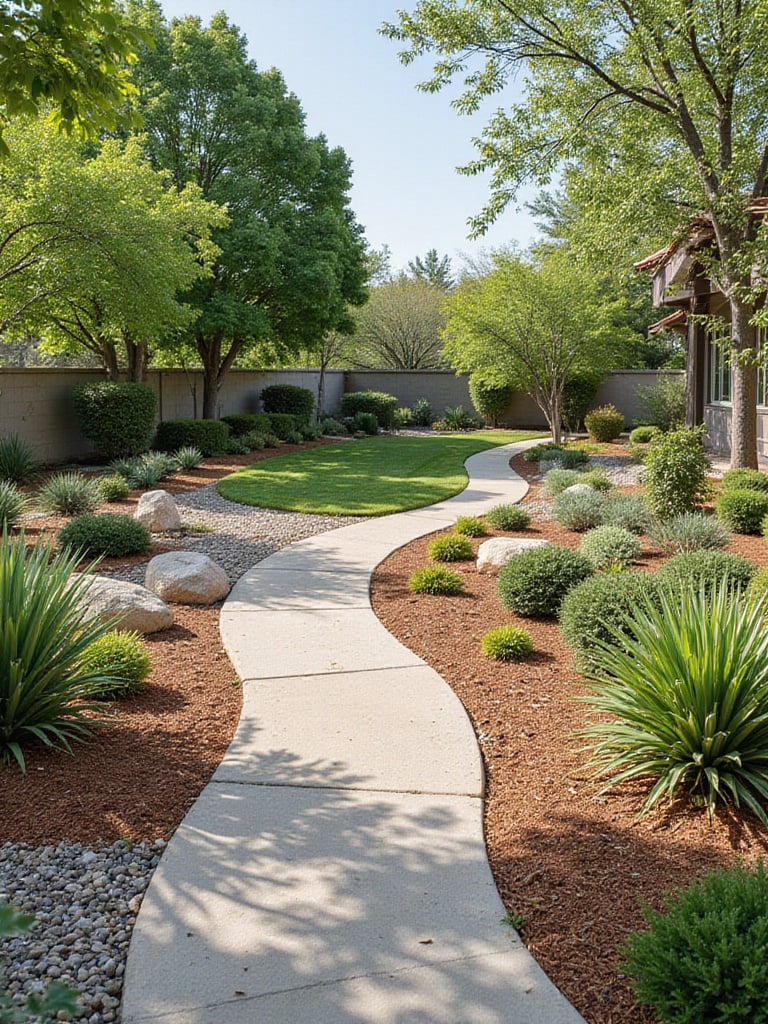
Replace large expanses of traditional lawn with groundcovers, ornamental grasses, or drought-tolerant perennial beds that require less mowing and watering. This approach not only reduces maintenance but often creates more visual interest and ecological value than conventional turf. Before making changes, analyze your site thoroughly—understanding your soil type, sun exposure patterns, and drainage across your yard will help you select plants and features that naturally thrive in your specific conditions.
What separates artisanal quality from mass-produced is the thoughtful integration of beauty and functionality—creating lawn garden ideas that work with nature rather than against it, resulting in spaces that improve with age and require less intervention to maintain their appeal.
Conclusion
Your lawn holds incredible potential to become so much more than just grass. By incorporating even a few of these lawn garden ideas, you transform ordinary outdoor space into a personal sanctuary that reflects your style, supports nature, and enhances your quality of life.
Remember that garden creation is a journey, not a destination. Start with the ideas that most inspire you, then allow your lawn garden to evolve organically as you discover what brings you joy in the outdoor space. Whether you’re drawn to vibrant flower borders, tranquil water features, or productive vegetable beds, the most successful gardens are those that connect deeply with the people who tend and enjoy them.
Each thoughtful addition or change to your lawn garden creates not just beauty, but meaning—turning everyday outdoor space into a living expression of creativity, care, and connection to the natural world around us.
